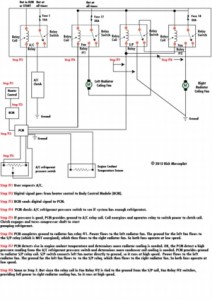Common Causes of Engine Overheating and How to Fix Them
Learn the most common causes of engine overheating and how to fix them
Engine overheating is one of the most common mechanical failures, and it can lead to catastrophic engine damage if not addressed promptly. While overheating can sometimes be caused by a major problem component failure, it is most often caused by smaller issues that cascade into a larger temperature spike. Let’s look at some of the top causes of overheating and how you can prevent these hot-tempered meltdowns.
Here are the most common causes of engine overheating
Low on coolant due to leak in radiator hoses, the radiator, heater core or heater hoses
Bad thermostat that is only partially open or stuck closed
Inoperative electric radiator fan
Clogged radiator fins that restrict airflow through the radiator
Clogged radiator
Worn out water pump
Damaged head gasket
Check coolant level first if you notice engine overheating
Low coolant makes the car overheat at idle but the temp gauge may show lower temps at highway speeds. At idle, the water pump rotates at a slower speed, and with less coolant in the system, it overheats. But at highway speeds, the water pump runs at a high enough speed to force the remaining coolant through the radiator and engine.
If the coolant shows low in the reservoir, add more coolant and see if that stops the overheating. If you have to add coolant more than once a year, you’ve got a leak so get it checked out.
A bad thermostat can cause engine overheating
The thermostat regulates the flow of coolant through the 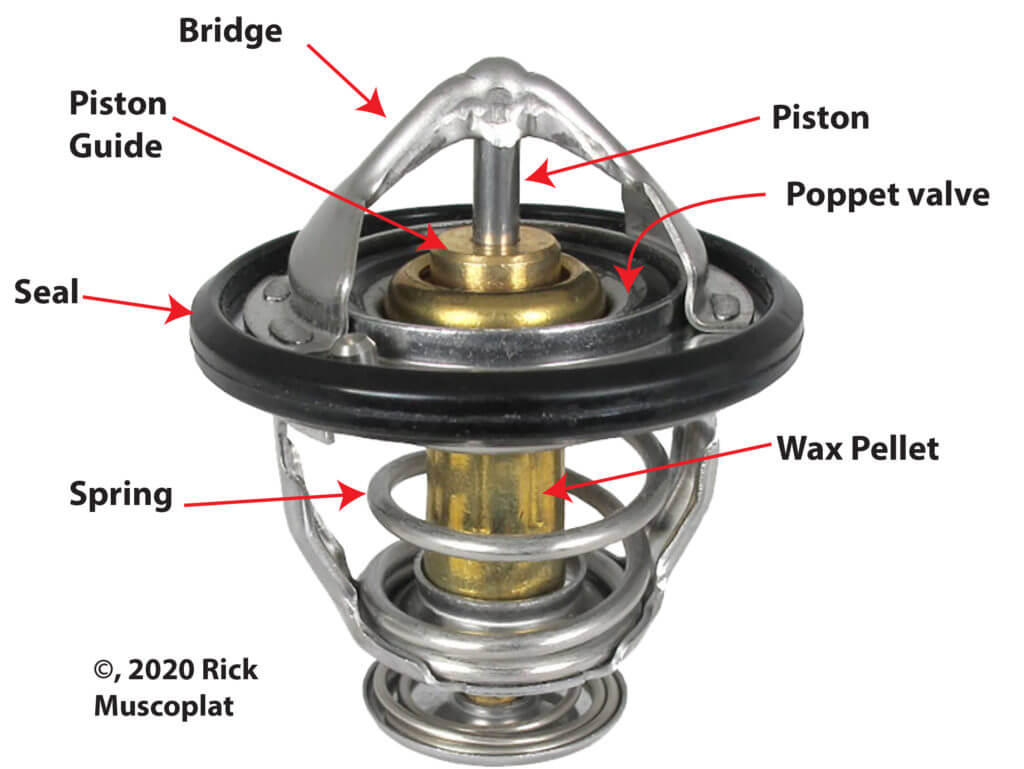 engine. If it’s on the fritz and it’s stuck in the fully closed or almost closed position, it’ll restrict coolant flow and cause an overheat condition.
engine. If it’s on the fritz and it’s stuck in the fully closed or almost closed position, it’ll restrict coolant flow and cause an overheat condition.
A bum radiator fan can cause engine overheating
Radiator fans come in two varieties: mechanically driven by the engine, or electric. If they’re not working, you’ll wind up overheating, especially at idle and with AC on.
Clogged radiator fins or clogged AC condenser fins can cause an overheat condition
In order to remove heat from the coolant, you must have adequate airflow through the radiator. You’ll often find the AC condenser and radiator coated in dust, dirt, and dead bugs. If air can’t get through the fins, the radiator can’t cool. The condenser coil is mounted in front of the radiator, so clean that first. It’s easy to do with a garden hose and pistol type sprayer. Just spray a high-pressure jet of water down the cooling fins to wash off the crud.
A clogged radiator can cause car overheating
People always discount how important the radiator is in an overheating situation. The cooling tube passages are very small. If you haven’t been good about changing coolant at recommended intervals, they can clog up with corrosion. If you own one of those newer non-contact infra-red
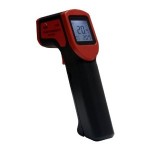
Non-contact infra-red thermometer
thermometers, use it to check the condition of your radiator.
With the engine running and thermostat open, just point it at the fins near the upper radiator hose. Then scan it across and down the radiator. You’ll be looking for cold spots. That indicates a blockage. If you find any, don’t waste your time trying to clean the radiator. The flushing chemicals can remove some of the buildup, but experience shows that by that point the corrosion has eaten up so much metal, that you’ll be left with pinholes in the metal tubes. A radiator that’s working should show hotter near the location where the upper radiator hose enters, and much cooler readings towards the bottom where the coolant leaves.
A worn water pump can cause engine overheating
If you have access to the radiator cap, you just remove it and watch the coolant flow. Increase idle speed and the coolant flow should increase with it. If you can’t get access to the radiator (no cap on newer systems that use the overfill bottle as the cap), you’ll have to clamp the upper radiator hose to feel coolant movement. Careful, it’ll be hot, so wear gloves.
Mechanical viscous clutch radiator fan
Mechanical fans always have a clutch mechanism. The clutch determines how much engine rotation is transferred to the fan blades.
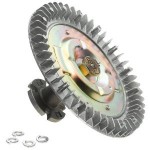
Viscous fan clutch controlled by bi-metallic coil
At idle, the clutch provides full rotation to the fan blades to suck in as much air as possible and provide maximum airflow across the radiator cooling fins. But at highway speeds, the force of incoming “ram” air is actually greater than the sucking provided by the fan. In fact, at highway speeds, the fan slows down airflow, so the clutch disengages and the clutch free-wheels. This is done to increase fuel efficiency and maximize airflow.
Carmakers use two types of fan clutches; a viscous controlled by a bimetallic strip, and a viscous clutch controlled by electrical current.
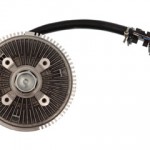
Electrically controlled viscous fan clutch
Both types can fail. And when they do they can slip at idle resulting in far less airflow than you need. If you have a mechanical fan and experience overheating at idle but not at highway speeds and your coolant levels are where they should be, suspect a bad fan clutch.
Electric Radiator Fans
Next are the electric fans. The early models have fairly simple operating circuits. The PCM reads the engine coolant temperature and provides ground to the fan relay when it determines the system needs more cooling. The relay provides power to the fan and it runs up to speed.
Older systems:
To diagnose these older systems, start by checking the fuse for the radiator fan. If it’s good, check the operation of the fan itself. Start the vehicle and turn the AC to MAX. The fan should start up. If it doesn’t you know there’s a problem. Start by checking the relay. You can do that by finding another relay with the same part number inside the fuse box and swapping them. If the fan still won’t run, you’ll need a non-contact infra-red thermometer and a digital multimeter. Locate the battery voltage pin of the fan relay socket going to the relay switch. Then locate the pin with battery voltage going to the relay control coil. Next, start the engine and measure the temperature of the water outlet with the thermometer. As it reaches 195, use your meter to test for power on both of those pins. And check for ground on the PCM side of the relay. If the PCM isn’t providing ground, the relay can’t operate and no power will flow to the electric fan. The weak link in these systems is usually the engine coolant temperature sensor. There’s a way to test it, but the sensor is only about $20 and it takes less time to replace it than test it.
Late-model systems:
But those were the early systems. The newer
systems are far more complicated. The PCMs in these systems take into account not only engine temperature, but AC pressures, the position of the accelerator pedal (cuts off AC during heavy acceleration to reduce engine load), and transmission fluid temps. Click on the PDF below to see how complicated they’ve become. But that doesn’t mean you can’t diagnose them. Just follow my step by step instructions
Also notice that many of these systems use two-speed fans. So the fact that an electric radiator fan is running at idle doesn’t mean it’s going to run at full speed later.
A head gasket leak can cause engine overheating
Head gaskets can fail in many different ways; by allowing oil into the coolant or coolant into the oil, coolant into the combustion chamber, which causes white smoke from the exhaust, OR combustion gasses to enter the cooling system.
If the head gasket fails between the combustion chamber and the cooling system, the engine will pump red-hot combustion gases into the coolant, superheating it and sending your temperature gauge to the moon.
The symptoms of a head gasket failure are:
Coolant overflowing from your coolant reservoir
Radiator hoses pop off due to the high pressure
Radiator hoses are rock hard due to the high pressure
The cooling system is always low on coolant.
If you suspect a bad head gasket, see this post for tips on how to diagnose the engine.
Final note:
Carmakers install plastic shrouds around their fans to provide maximum wind tunnel sucking properties. And they install baffles around the radiator to direct air through the radiator instead of around it. If anyone has ever removed the radiator and not replaced those components in exactly the right place, that can disturb the airflow and reduce cooling.
Also, most late model cars are equipped with an air dam under the front bumper. This deflector is there for a reason—to deflect air upwards towards the radiator. If yours is missing and your vehicle overheats at highway speeds, the missing air dam may be the culprit.
© 2012 Rick Muscoplat
Posted on by Rick Muscoplat

